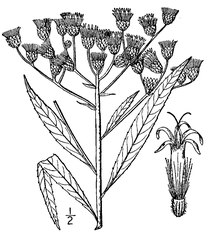High bill aster
| High bill aster | ||||||||||||
|---|---|---|---|---|---|---|---|---|---|---|---|---|

High false aster ( Vernonia gigantea ) |
||||||||||||
| Systematics | ||||||||||||
|
||||||||||||
| Scientific name | ||||||||||||
| Vernonia gigantea | ||||||||||||
| ( Walter ) Branner & Coville |
The high mock aster ( Vernonia gigantea ) is a species of the mock aster ( Vernonia ).
features
The Hohe Scheinaster is a bare, perennial, herbaceous plant that reaches heights of 1 to 2 (rarely up to 3) meters. The plant forms a rhizome . The leaves are 15 to 25 centimeters long, 3 to 7 centimeters wide, eilanzettlich, long, pointed, hardly dotted with glands and serrated forward. The teeth have a cartilage tip. The heads consist of 13 to 30 flowers. The bracts are tile-like, pressed and green with a purple tip. There are no thread-like extensions. The shell is 4 to 5 millimeters long and wide. The flower and pappus are purple.
The flowering period extends from August to September, rarely until October.
Occurrence
The Hohe Scheinaster occurs in south-eastern Canada and in the eastern and central USA in wet forests.
use
The Hohe Scheinaster is rarely used as an ornamental plant for pond edges and natural gardens. The species has been in culture since 1820 at the latest.
supporting documents
- Eckehart J. Jäger, Friedrich Ebel, Peter Hanelt, Gerd K. Müller (eds.): Rothmaler excursion flora from Germany. Volume 5: Herbaceous ornamental and useful plants . Spectrum Academic Publishing House, Berlin Heidelberg 2008, ISBN 978-3-8274-0918-8 .
